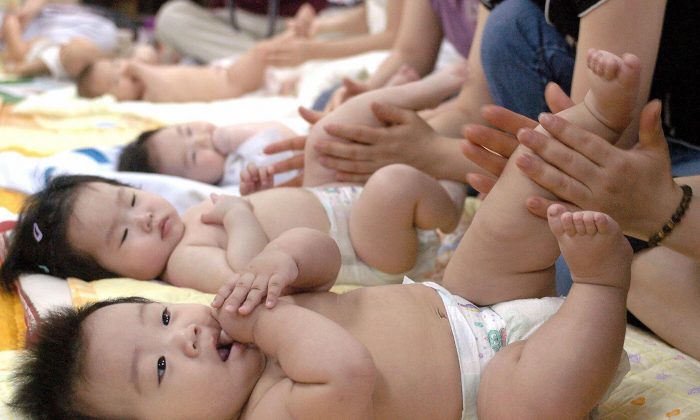South Korea’s fertility rate, which is the lowest in the world, has risen for the first time in nine years, accompanied by a big jump in marriages.
South Korea’s fertility rate—which is the lowest in the world—saw a slight rise in 2024 for the first time in nine years, according to preliminary data published by Statistics Korea on Feb. 26.
The country’s fertility rate—the average number of babies a woman has during her reproductive life—rose to 0.75 in 2024, from 0.72 the previous year.
Statistics Korea said the number of marriages rose by 14.9 percent in 2024, the biggest jump since the data began to be compiled in 1970.
South Korea’s fertility rate fell for eight consecutive years—from 1.24 in 2015—to become the lowest in the world.
It is the only member of the Organisation for Economic Co-Operation and Development countries with a rate below 1, and the government in Seoul has raised concerns in recent years about the social and economic effects of the fall.
The fertility rate in the capital, Seoul, is even lower than the national average, at 0.58.
After he was elected in 2022, President Yoon Suk Yeol declared a “national demographic crisis” and laid out a plan to create a new ministry devoted to pushing up fertility rates.
Yoon—who was impeached recently for his role in declaring martial law on Dec. 3, 2024—promoted various measures to encourage young people to get married and have children.
In South Korea, where there are few children born out of wedlock, there is a predicted time lag of one or two years before the birth rate—the number of live human births per 1,000 people—begins to rise.
‘Change In Social Value’
Park Hyun-jung, an official at Statistics Korea, told a briefing on Feb. 26, “There was a change in social value, with more positive views about marriage and childbirth.”
Park said the COVID-19 pandemic delayed some couples in having children, and he said there was also a rising number of people in their 30s.
He said, “It is difficult to measure how much each factor contributed to the rise in new births, but they themselves had an impact on each other too.”
In Sept. 2018, Kim Sung-Jin, 34, a resident of Suwon, just south of Seoul, told The Epoch Times why he had put off getting married and having children.
Kim said: “Housing is not affordable … As basic needs are not met, people just stay single. The atmosphere is that people are choosing not to produce slaves.”
Another reason that has been given for the low fertility rate in South Korea is the fact that many parents spend enormous sums of money on private education and other tutoring, which means they often feel unable to afford more than one child.
Statista reported the average monthly expenditure per student in South Korea for private education was 431,000 won ($300) in 2023.
In 2021, Seongeun Kim, an associate professor of economics at Sejong University in Seoul, published a paper in which he explained the link between education costs and low fertility rates.
He wrote, “East Asians, especially South Koreans, appear to be preoccupied with their offspring’s education—most children spend time in expensive private institutes and in cram schools in the evenings and on weekends.”
Demographers consider 2.1 the so-called replacement level, meaning countries with fertility rates below that level will gradually see their populations shrink and age.
Population Set To Shrink
South Korea’s population, which hit a peak of 51.83 million in 2020, is expected to shrink to 36.22 million by 2072, Statistics Korea predicted.
Japan, which also has a very low fertility rate, has a rapidly aging population, and both Japan and South Korea have resisted immigration, which could lead to a potential future shortage of people of working age.
In July 2023, demographer Paul Morland, speaking to NTD’s Lee Hall for the “British Thought Leaders” program, said that South Korea’s fertility rate was worryingly low and was a warning to Western countries.
Morland said South Korea’s fertility rate in 2020 was 0.9, compared with 1.2 in Japan and 1.58 in England and Wales.
In his book, “Tomorrow’s People: The Future of Humanity in 10 Numbers,” he said developed countries such as South Korea, Japan, Britain and the United States faced a “trilemma.”
Morland said: “So the trilemma is, you can have two out of three things but not all three. You can have a growing economy, which requires some sort of growing workforce; you can have a low fertility rate; and you can have ethnic homogeneity and continuity, but you can’t have all three of those.”
Reuters contributed to this report.

